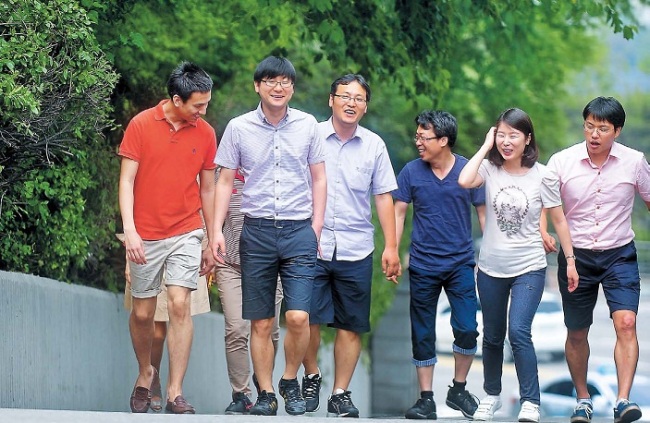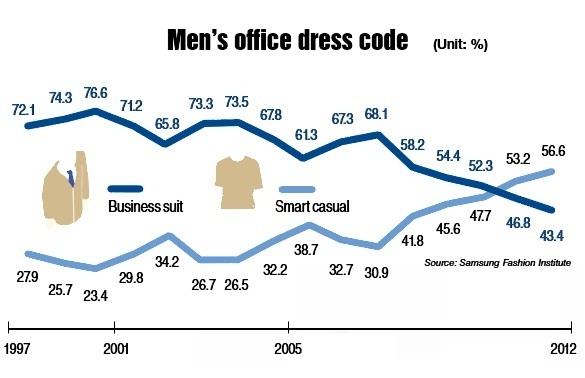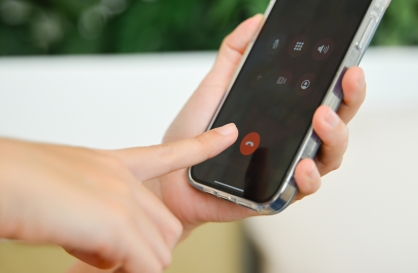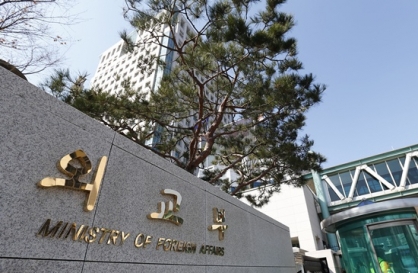POSCO employee Woo Ji-hoon sometimes goes to work wearing jeans and a T-shirt these days.
“It depends on the department (in our company), but the overall policy is to dress freely. Unless you are not wearing sandals and shorts, in the case of men, most outfits are allowed,” he said.
Now every day is a “casual day” for workers at POSCO as the nation’s largest steelmaker made an official announcement last month that employees are allowed to wear business casuals in the office. The company had designated every Friday a “casual day” in 2000 to allow employees to dress down on the final weekday.
“There is no standard in how to dress. Employees can decide for themselves what fits to ‘business casual’ and wear them. On average, men wear cotton pants and colored shirts,” said Jeong Yong-min, a PR official at POSCO.
“The chairman minds greatly about enhancing employees’ creativity. For example, we have a playroom on the fourth floor of the POSCO center where employees can enjoy some free time and play board games. Dressing down can be considered an extension of such measures to enhance creativity.”
The company also recently got rid of cubicles and renovated the working space into a “smart office” where rooms have different interior designs and desks arrangements depending on the type of work to be done there.
“With the dress code toned down to business casual, on top of smart offices, employees seem to feel more comfortable about coming to work,” Jeong said.
Offices are going smart casual in South Korea in terms of dress code, benchmarking successful companies like Google, which is known for its unrestrained working atmosphere, and also in step with the “Cool Biz” move initiated by the government to encourage workers to dress casual and light to reduce energy consumption.
Civil servants working at Seoul Metropolitan Government have been going to work without jackets or ties but with polo shirts on and sometimes even in shorts and sandals. They are allowed to be “cool” during the three-month “Super Cool Biz” period that runs through August.
“It depends on the department (in our company), but the overall policy is to dress freely. Unless you are not wearing sandals and shorts, in the case of men, most outfits are allowed,” he said.
Now every day is a “casual day” for workers at POSCO as the nation’s largest steelmaker made an official announcement last month that employees are allowed to wear business casuals in the office. The company had designated every Friday a “casual day” in 2000 to allow employees to dress down on the final weekday.
“There is no standard in how to dress. Employees can decide for themselves what fits to ‘business casual’ and wear them. On average, men wear cotton pants and colored shirts,” said Jeong Yong-min, a PR official at POSCO.
“The chairman minds greatly about enhancing employees’ creativity. For example, we have a playroom on the fourth floor of the POSCO center where employees can enjoy some free time and play board games. Dressing down can be considered an extension of such measures to enhance creativity.”
The company also recently got rid of cubicles and renovated the working space into a “smart office” where rooms have different interior designs and desks arrangements depending on the type of work to be done there.
“With the dress code toned down to business casual, on top of smart offices, employees seem to feel more comfortable about coming to work,” Jeong said.
Offices are going smart casual in South Korea in terms of dress code, benchmarking successful companies like Google, which is known for its unrestrained working atmosphere, and also in step with the “Cool Biz” move initiated by the government to encourage workers to dress casual and light to reduce energy consumption.
Civil servants working at Seoul Metropolitan Government have been going to work without jackets or ties but with polo shirts on and sometimes even in shorts and sandals. They are allowed to be “cool” during the three-month “Super Cool Biz” period that runs through August.

On Wednesday, the second-hottest day of this year so far as the temperature hit 31 degrees Celcius, six out of 13 workers at Seoul Metropolitan Government’s environmental policy division wore short sleeves and shorts.
“It was awkward at first to see workers in casual style, but now it looks better and cooler,” said Baek Ho, general director at the city’s transportation policy bureau.
The city also held a cool biz fashion show earlier this month to promote the campaign, starring Seoul Mayor Park Won-soon as one of the models.
Other governmental organizations including the presidential office of Cheong Wa Dae are also taking part in the cool biz dress code. President Lee Myung-bak and all senior presidential secretaries, for example, attended a weekly meeting last month in short sleeves to save energy.
“It is important not only to reduce the indoor temperature in general, but also to cool yourself,” President Lee said at the time.
“The work we do here requires a high level of concentration so wearing casual clothes at work has been allowing us to think more flexibly and creatively,” said Kim Jong-soo, deputy director of the General Service Division at Korean Intellectual Property Office which also participates in the “Cool Biz” trend.
According to Samsung Fashion Institute which has been researching what men have worn to work since 1997, 56.6 percent of business men in Gwanghwamun, Yeouido and Samseong-dong were dressed in business casual and 43.4 percent were in suits on May 10. The number of casually dressed men has been on a steady increase since 2008 when it marked 41.8 percent.

In terms of accessories, backpack wearers increased in all ages, according to the report. Denim shirts were more frequently spotted than previous years especially among young workers, and jeans were more widely found even among the older generations.
The shift from suits to business casual is also evident in stores. At Lotte Department Store, suits used to take up 80 percent of the menswear section in 2009 while casual clothes made up 20 percent. Now, the ratio is fifty-fifty.
Changes are found in sales of shoes and accessories as well; although about 80 to 90 percent of the customers purchased black shoes until two to three years ago, now over 70 percent look for brown shoes that better match the business casual look. And while accessories used to take up below 3 percent of the showroom display in menswear brands, now the items make up more than 10 percent.
Sales of neckties, however, decreased by 9.6 percent in the first five months of this year compared to the same period last year.
“We can see more businessmen dressed more casual, wearing no ties on the streets. It seems that the cool biz look quite settled down in companies and also governmental organizations,” said Kim Seong-hwan, a menswear merchandiser at Lotte Department Store in Seoul.
Yes, it is now in fact more difficult to find companies that do not allow business casual or the cool biz dress code. Most companies instead actively encourage employees to dress light.
Cosmetics brand Amore Pacific, for example, recently set up photos of models wearing recommended cool biz outfits for the office building.
“Amore Pacific introduced the ABC Style Look which refers to a decent business look that is slightly more formal than regular casual. It is designated as AP Cool Biz period from June 1 to Aug. 31, during which employees can work wearing no ties and no jackets, even when they have to give presentations,” said Kweon Sung-hae, PR official of the brand.
Some, however, complain that going smart casual is only causing headaches.
“Some colleagues complain that now they only have to spend more on clothes to keep up with the new business casual trend,” said an employee at a local conglomerate who declined to give his name.
Jang Hyun-suk, an official from Changwon City Government, voiced that society still expects a certain dress code for civil workers.
“To maintain the integrity of civil workers, we don’t allow shorts and sandals. However, we’ve been allowing no-tie and short-sleeve tops to promote energy conservation,” said Jang.
Workers who often have to attend meetings outside the office also find the new trend troublesome.
“Inside the office I am putting on a pair of sandals and wearing shorts, and outside I wear trousers and a jacket,” said Hwang Chi-young, director-general of Seoul Metropolitan Government’s climate change bureau.
Citizens also have mixed reactions.
“Trust is the most important value for public workers. Wearing T-shirts or short pants seem to show that the people do not take their job seriously,” said Lee Sang-hyun, a 32-year-old office worker.
“If civil servants work in a cool environment, they will able to provide better services to citizens,” said Kim Su-jeong, 28, also an office worker.
By Park Min-young, Kim Young-won & Lee Hee-su
(claire@heraldcorp.com, wone0102@heraldcorp.com, hs@heraldcorp.com)
-
Articles by Korea Herald




![[Weekender] Korean psyche untangled: Musok](http://res.heraldm.com/phpwas/restmb_idxmake.php?idx=644&simg=/content/image/2024/05/02/20240502050841_0.jpg&u=)

![[Eye Interview] 'If you live to 100, you might as well be happy,' says 88-year-old bestselling essayist](http://res.heraldm.com/phpwas/restmb_idxmake.php?idx=644&simg=/content/image/2024/05/03/20240503050674_0.jpg&u=)











![[Herald Interview] Director of 'Goodbye Earth' aimed to ask how we would face apocalypse](http://res.heraldm.com/phpwas/restmb_idxmake.php?idx=652&simg=/content/image/2024/05/03/20240503050732_0.jpg&u=)
